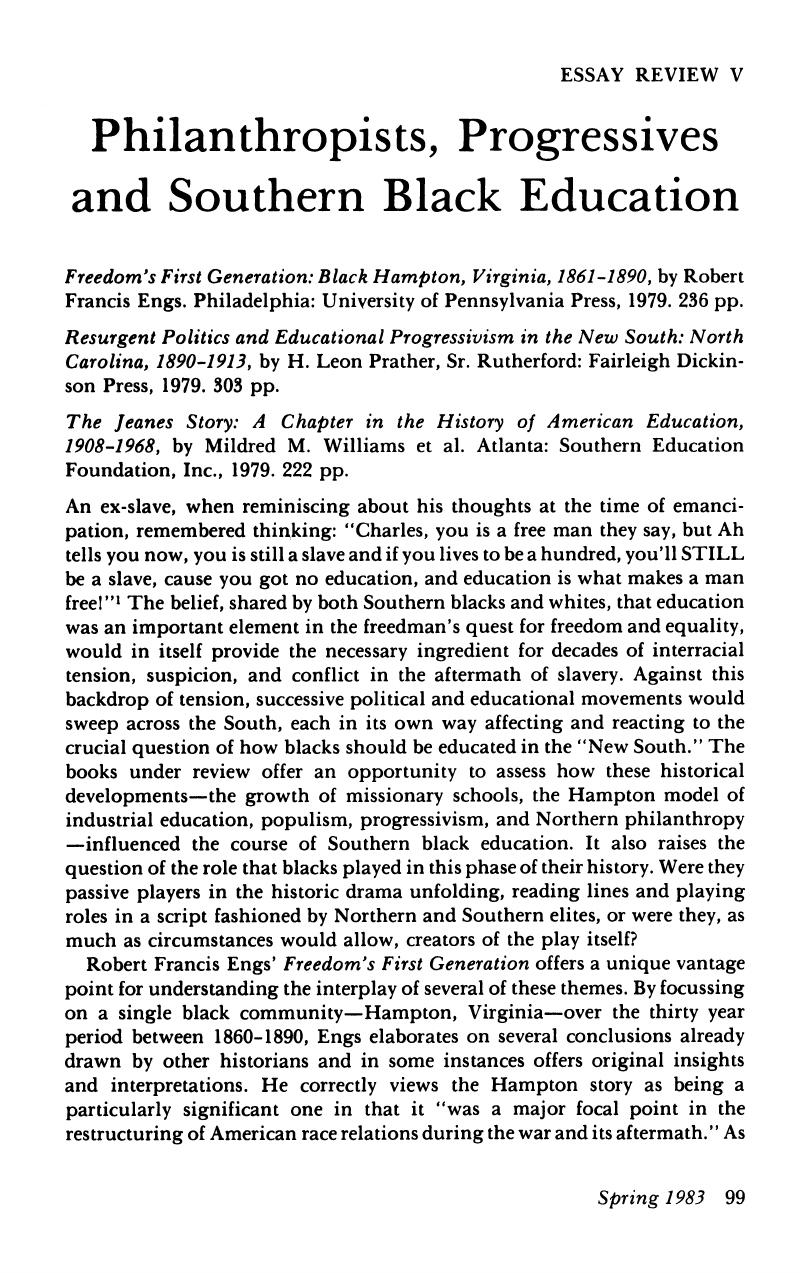No CrossRef data available.
Published online by Cambridge University Press: 24 February 2017

1. Quoted in Litwack, Leon F., Been in the Storm So Long: The Aftermath of Slavery (New York, 1979), p. 472.Google Scholar
2. Swint, Henry Lee, The Northern Teacher in the South, 1862–1870 (Nashville, Tennessee, 1941 [1967 Octagon edition]), p. 77; Litwack, , Been in the Storm So Long, p. 477; McPherson, James M., The Abolitionist Legacy: From Reconstruction to the NAACP (Princeton, 1975), p. 201; and Jones, Jacqualine, Soldiers of Light and Love: Northern Teachers and Georgia Blacks, 1865–1873 (Chapel Hill, North Carolina, 1980), p. 208.Google Scholar
3. Engs, Robert Francis, Freedom's First Generation: Black Hampton, Virginia, 1861–1890 (Philadelphia, 1979), pp. 62, 65, 136, xix.Google Scholar
4. Major interpretations of Armstrong's views and Hampton's approach to black education are Talbot, Edith Armstrong, Samuel Chapman Armstrong: A Biography (New York, 1904); Peabody, Francis Greenwood, Education for Life: The Story of Hampton Institute (New York, 1908); Carson, Suzanne, “Samuel Chapman Armstrong: Missionary to the South” (Ph.D. Dissertation, Johns Hopkins University, 1952); Anderson, James D., “The Hampton Model of Normal School Industrial Education, 1868–1900,” in New Perspectives on Black Educational History , eds. Franklin, Vincent P. and Anderson, James D. (Boston, 1978); and Spivey, Donald, Schooling for the New Slavery: Black Industrial Education, 1868–1915 (Westport, 1978), chapter 2. Hampton's Indian work is treated in Peabody, , Education for Life, chapter 6; Adams, David Wallace, “Education in Hues: Red and Black at Hampton Institute, 1878–1893,” South Atlantic Quarterly 76 (Spring 1977): 159–176; Robinson, William H., “Indian Education at Hampton Institute,” in Stony the Road: Chapters in the History of Hampton Institute , ed. Schall, Keith L. (Charlottsville, Virginia, 1977), pp. 1–33; and Tingey, Joseph Willard, “Indians and Blacks Together: An Experiment in Biracial Education at Hampton Institute (1878–1923)” (Ed.D. Dissertation, Teachers College, Columbia University, 1978).Google Scholar
5. For a discussion of Indian-black comparisons see Adams, , “Education in Hues.” Armstrong's views on black morality are discussed in Anderson, , “The Hampton Model,” pp. 65–66; and Engs, , Freedom's First Generation, pp. 142–145.Google Scholar
6. Anderson, , “The Hampton Model,” p. 62.Google Scholar
7. Engs, , Freedom's First Generation, pp. 160, 154, 160.Google Scholar
8. Engs, , Freedom's First Generation, pp. 155–156, 159; and Anderson, , “The Hampton Model,” pp. 78–81.Google Scholar
9. Leon Prather, H. Sr., Resurgent Politics and Educational Progressivism in the New South: North Carolina, 1890–1913 (Rutherford, N.J., 1979), p. 11.Google Scholar
10. Vann Woodward, C., Origins of the New South, 1877–1913 (Baton Rouge, Louisiana, 1951 [1966 edition]), p. 249.Google Scholar
11. Woodward, , Origins of the New South, p. 253.Google Scholar
12. Prather, , Resurgent Politics, p. 270.Google Scholar
13. Gaither, Gerald H., Blacks and Populist Revolt: Ballots and Bigotry in the “New South” (University, Alabama, 1977), pp. 130, 81; Degler, Carl N., The Other South: Southern Dissenters in the Nineteenth Century (New York, 1974 [Harper Torchbooks: 1975]), p. 338; and Woodward, , Origins of the New South, p. 250.Google Scholar
14. Harlan, Louis R., Separate and Unequal: Public School Campaigns and Racism in the Southern Seaboard States, 1901–1915 (Chapel Hill, 1958 [Atheneum, 1969]), p. 131.Google Scholar
15. Quoted in Prather, , Resurgent Politics, p. 279. For Link's views on Southern progressivism see Link, Arthur S., “The Progressive Movement in the South, 1870–1914,” North Carolina Historical Review 23 (April 1946): 172–195.Google Scholar
16. Prather, , Resurgent Politics, pp. 283, 277. Other historians' accounts of Southern progressivism are Link, , “The Progressive Movement in the South,” pp. 172–195; Woodward, , Origins of the New South, chapter 14; and Ezell, John Samuel, The South Since 1865 (New York, 1975 [2nd edition]), chapter 20.Google Scholar
17. Prather, , Resurgent Politics, p. 283.Google Scholar
18. Prather, , Resurgent Politics, pp. 280, 222.Google Scholar
19. Woodward, , Origins of the New South, chapter 15; Harlan, , Separate and Unequal, chapter 3; and Bullock, Henry Allen, The History of Negro Education in the South from 1619 to the Present (Cambridge, 1967 [Praeger, 1970]), chapters 4–5.Google Scholar
20. Prather, , Resurgent Politics, p. 382.Google Scholar
21. Anderson, James D., “Northern Foundations and the Shaping of Southern Black Rural Education, 1902–1935,” History of Education Quarterly 18 (Winter 1978); 392. Also see Anderson, James D., “Education as a Vehicle for the Manipulation of Black Workers,” in Work, Technology, and Education: Dissenting Essays in the Intellectual Foundations of American Education , eds. Feinberg, Walter and Rosemont, Henry Jr. (Urbana, Illinois, 1975), pp. 15–40; and Spivey, , Schooling for the New Slavery, chapter 4.CrossRefGoogle Scholar
22. Bullock, , A History of Negro Education, pp. 137, 146; and Anderson, , “Northern Foundations:” 383–384.Google Scholar